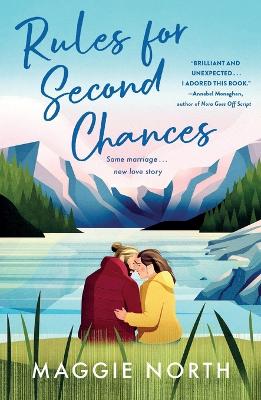
chymerra
I was not expecting how this book would feel when I accepted the widget the publisher sent me. I had read the blurb and thought this would be quick and easy. Yeah, that wasn’t the case. Put it this way: I was a teary mess as the book ended. Since I read at night, that woke my husband up, and I tried to explain what set me off.
The main storyline for Rules for Second Chances is centered on Liz. When the book starts, Liz is hurrying to her thirtieth birthday party, which is thrown for her by her very popular, extroverted husband, Tobin. Liz loses her shit when a guest mistakes her for a server at her party. It pushes Liz to realize that she must take control of her life. And her way of doing that? Joining an improv class run by her husband’s best friend and asking Tobin for a divorce. Realizing she is terrible at improv, Liz decides to ask Tobin to help her practice. As she and Tobin grow closer, Liz begins to think that her social awkwardness might have a more profound meaning. Will she fold with pressure mounting at the wilderness guide company they both work for and in Liz’s personal life? Or will Liz roll with the punches, like improv has taught her? And most importantly, will she be able to save her marriage?
I started this book not liking Liz. The author didn’t give a lot of background to her. She worked with Tobin at the same wilderness guide company but was extremely socially awkward and insecure. But my dislike of her didn’t even last through the first chapter. The author made it almost painfully clear that Liz, for most of her life, was made to feel like she was a spectator in her own life. I loved seeing her character grow throughout the book. By the end of the book, she went from this mousy person who hated confrontation to this self-assured woman. It took Liz a lot of work to get where she was at the end of the book, but it was worth the journey.
Tobin was quickly my favorite character in Rules for Second Chances. He loved Liz and was willing to do anything to fix their marriage (the Little Mermaid scene will be forever etched into my brain). I liked that Tobin wasn’t as confident as he was made out to be. I also liked that he owned his mistakes and that, during one crucial scene, he was willing to let Liz go—because it would make her happy.
I did have characters I didn’t like, but I will touch on two because they were the most prevalent. I was not fond of Tobin’s father and Liz’s older sister. I was furious with both during different parts of the book. Tobin’s father was a piece of work (he was a piece of shit who managed to help ruin their wedding and an anniversary dinner). But Liz’s sister took home the award for the biggest asshole to date. She had her suspicions about Liz having autism, but instead of talking to Liz about it, she sat on it. It wasn’t in a normal conversation when she decided to tell Liz her suspicions. Instead, it was blurted out in an argument, which made it somewhat worse for Liz to hear. The author did attempt to have Liz’s sister redeem herself towards the end of the book. But Tobin’s father jetted and was only mentioned once or twice after that scene.
I loved the secondary storyline that revolved around the improv group and the self-help book. Those were some of the funniest scenes in the book, but they were also some of the most heartbreaking.
I liked how the author handled Liz’s journey through her autism diagnosis. The author’s forward explains that she wrote Liz’s character and autism journey to the best of her ability and that Liz doesn’t portray every adult autism diagnosis.
The end of Rules for Second Chances was terrific. I loved how the author ended things for Tobin and Liz. It was the perfect ending for this book!!
Many thanks to St. Martin’s Press, St. Martin’s Griffin, NetGalley, and Maggie North for allowing me to read and review this ARC of Rules for Second Chances. All opinions stated in this review are mine.

